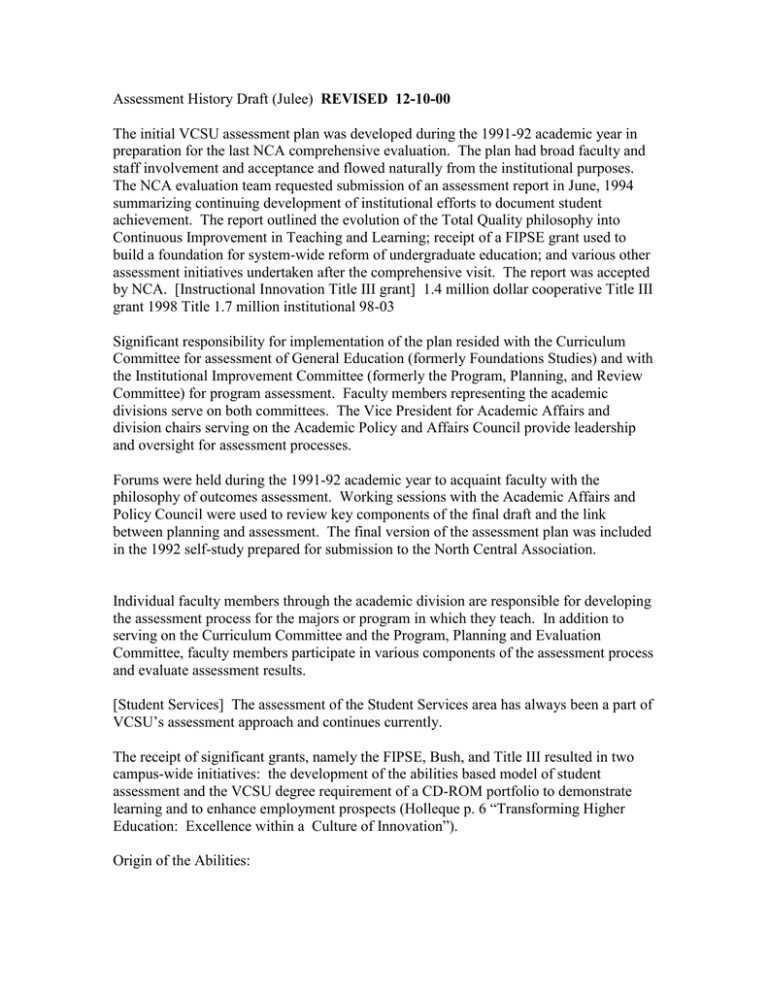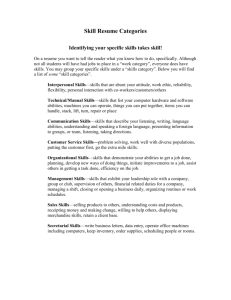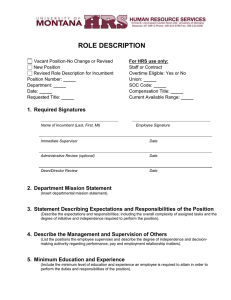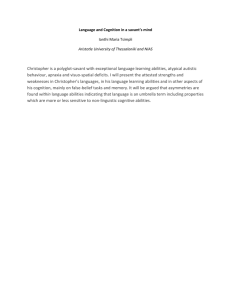Assessment History.doc
advertisement

Assessment History Draft (Julee) REVISED 12-10-00 The initial VCSU assessment plan was developed during the 1991-92 academic year in preparation for the last NCA comprehensive evaluation. The plan had broad faculty and staff involvement and acceptance and flowed naturally from the institutional purposes. The NCA evaluation team requested submission of an assessment report in June, 1994 summarizing continuing development of institutional efforts to document student achievement. The report outlined the evolution of the Total Quality philosophy into Continuous Improvement in Teaching and Learning; receipt of a FIPSE grant used to build a foundation for system-wide reform of undergraduate education; and various other assessment initiatives undertaken after the comprehensive visit. The report was accepted by NCA. [Instructional Innovation Title III grant] 1.4 million dollar cooperative Title III grant 1998 Title 1.7 million institutional 98-03 Significant responsibility for implementation of the plan resided with the Curriculum Committee for assessment of General Education (formerly Foundations Studies) and with the Institutional Improvement Committee (formerly the Program, Planning, and Review Committee) for program assessment. Faculty members representing the academic divisions serve on both committees. The Vice President for Academic Affairs and division chairs serving on the Academic Policy and Affairs Council provide leadership and oversight for assessment processes. Forums were held during the 1991-92 academic year to acquaint faculty with the philosophy of outcomes assessment. Working sessions with the Academic Affairs and Policy Council were used to review key components of the final draft and the link between planning and assessment. The final version of the assessment plan was included in the 1992 self-study prepared for submission to the North Central Association. Individual faculty members through the academic division are responsible for developing the assessment process for the majors or program in which they teach. In addition to serving on the Curriculum Committee and the Program, Planning and Evaluation Committee, faculty members participate in various components of the assessment process and evaluate assessment results. [Student Services] The assessment of the Student Services area has always been a part of VCSU’s assessment approach and continues currently. The receipt of significant grants, namely the FIPSE, Bush, and Title III resulted in two campus-wide initiatives: the development of the abilities based model of student assessment and the VCSU degree requirement of a CD-ROM portfolio to demonstrate learning and to enhance employment prospects (Holleque p. 6 “Transforming Higher Education: Excellence within a Culture of Innovation”). Origin of the Abilities: Up until the fall semester of 1995, the General Education requirements were titled Foundation Studies. The Curriculum Committee conducted oversight of these requirements including any changes, additions, deletions, or evaluation of the courses. The Foundation Studies objectives (listed on page 36-37 of the Focused Visit Report, April 24-25, 1996) provided a common set of objectives for all Foundation Studies courses. As part of the FIPSE grant activities, faculty voluntarily met on a regular basis (Monday afternoons at 3:00 p.m.) for Learner Centered Education (LCE) meetings. A faculty member from the Division of Education and Psychology often facilitated these meetings, and the discussions focused on methods of teaching which encouraged student-centered activity and inquiry. Participating faculty members brought ideas and strategies to share with the group. These meetings provided an open form for meaningful discourse related to teaching and learning. One of the results of these LCE meetings was that the Curriculum Committee began to re-examine the Foundations Studies objectives in an attempt to determine whether or not the objectives were being met and whether or not the students were learning. The issue of “measurability” moved to the forefront as Valley City State University was preparing for the 1996 NCA Focused Visit. The University needed a method of “demonstrating” student attainment of the stated objectives. Through the LCE meetings and the actions of the Curriculum Committee, the Foundation Studies Objectives were revised. The results of the revision were seventeen “Foundation Studies Objectives Described as Abilities” (listed on pull-out page 41A of the Focused Visit Report, April 24-25, 1996). Each of these revised objectives was stated in such a way as to result in a demonstrable student achievement. Next, these objectives were revised, resulting in the eight Abilities which have become the focal point of learning assessment at Valley City State University. Specific demonstrable skills have been linked with each ability and are illustrated in the table below: Abilities Skills Aesthetic Engagement Receptivity Visualization Positive Interdependence Leadership Written Spoken Visual Performance Provides service to others Change agent skills Teaches Others Works with diversity Understands system interrelationships Gathering information Creative thinking Systems analysis Problem recognition Decision making Selects Applies Self-management Self-Worth Collaboration Communication Effective Citizenship Global Awareness Problem Solving Technology Wellness In addition to the General Education program, all academic programs have incorporated the eight Abilities into their assessment plans. The campus structure is such that programs are guided by departments and each department is part of one of the six academic divisions. Each academic division, through faculty discussion and collaboration, chose several of the eight university abilities, those most closely aligned with the goals of the division. Those abilities and their corresponding skills were then incorporated into programs, majors / minors, courses, and specific course projects. Divisions: The Division of Communication Arts and Social Science Goals: The general goals of the Division are: 1) to serve the fundamental needs of all students through courses aimed at achieving stated skills in the Communication Arts; 2) to help all students achieve a better understanding of the common cultural heritage, beliefs, and values through the study of the humanities; 3) to promote an understanding of social organization and interactions through the study of history and the social sciences; and 4) to promote global awareness and appreciation of diverse cultures through the study of language and opportunities to study in other countries. Abilities: Courses leading to a major in the Division of Communication Arts and Social Science will help students develop the following abilities: Communication: Aesthetic Engagement / Problem Solving: Problem Solving / Technology: Global Awareness: Excellent writing and speaking abilities Sophisticated analytical skills Competent researcher Synthesizes language, life, and culture Assessment Activities / Outcomes: The Division of Communication Arts and Social Science uses a multi-faceted assessment process to ensure high quality and promote valuable changes within its programs. Development of criteria and policies for admission to and continuance in the programs. Adoption of the Abilities Model. Clinical and field-based experiences with review by student, cooperating instructor or employer, and faculty mentor. Student portfolio development. Student evaluation of course objectives. Digital portfolios as an exit requirement. [Divisional improvement plan.] Assessment of student success takes place from entry to exit: General education courses are linked to the abilities. Major courses track abilities to higher levels. Portfolio development documents abilities. Successful completion of field experiences, internships, or study abroad. Divisional expectations of students are high: The Division and its programs have specific requirements, goals, and objectives. The requirements are linked to University abilities and skills. Specified course projects are linked to University abilities and skills. The Division builds systems for change through the following: Through assessment and reflection, abilities and portfolios continue to evolve. Definitions and rubrics for abilities and skills reflect University program objectives. Employer surveys provide input regarding the changing needs of the workplace. Exit information regarding new graduates is gathered through: Surveys of first-year teachers conducted by the VCSU Career Planning and Placement Office. Surveys of employers who have hired VCSU graduates conducted by the Career Planning and Placement Office. Focus group discussions with graduating seniors. Say something about how the assessment information goes back to faculty, students, programs, etc. The Division of Education and Psychology Goals: The broad goals of the teacher education program at Valley City State University are to prepare entry-level teachers who: (1) are capable of teaching and guiding students of varying backgrounds, strengths, and needs; (2) are competent decision makers; (3) are skilled in planning, implementing, and evaluating learning experience for students: (4) view decision making as a reflective process; (5) understand and are committed to the moral dimensions of teaching; (6) select and apply technology appropriately; and (7) accept the view that professional growth and development is an on-going, never-ending process. Abilities: In addition to developing the eight General Education Abilities at a higher level, students in the Education and Psychology Division will become proficient in the teaching abilities outlined in the Professional Decision Making Model; Planning, Implementing, and Evaluating. Planning: While planning, the teacher must make decisions regarding areas such as goals and objectives, the degree of background building required, and specific materials and methods to use. Implementation: The implementation function requires the teacher to carry out the plans that have been made. During the actual teaching phase numerous decisions need to be made. Often times, they need to be made quickly as the teacher responds to students reactions, comments, and instructional needs. As a result, modification of prepared plans becomes the rule rather than the exception. Evaluation: During the evaluation phase of decision making the teacher determines the degree to which the instructional objectives were attained. Determining the degree of reteaching that is needed, recording information, and reporting progress are some of the areas within the evaluation phase of decision making. Reflection: The teacher plans, implements, and evaluates by using feedback in a reflective manner. During the entire process it is essential the teacher realizes that professional growth and development is continuous. Assessment Activities / Outcomes: In its reaccreditation visit to VCSU, the 1996 visitation team from the National Council for Accreditation of Teacher Education recognized Valley City State University for Exemplary Practice and noted: Valley City State University through its collaborative work with the Center for Innovation in Instruction (CII) and the Kathryn Center, and through the initiative of its faculty in pursuing grants, has achieved a synergy of vision and mission in action which would not normally be possible for an institution of its size and financial resources. In this case, the whole is greater than the sum of its parts. Noting that institutional culture is notoriously resistant to change, VCSU has achieved virtual transformation of the culture of the entire institution…these multiple efforts have worked in concert, focusing philosophy, and broad range of human and financial resources, to create institution-wide movement toward their long range vision to be a leader in technology in education. While the entire campus community is credited for the commendable NCATE review, the unit faculty members and teacher education students played a critical leadership role and they continue to exert their influence as key players in the transformation of teaching and learning. The Division of Education and Psychology at Valley City State University has met the accreditation standards of the National Council for the Accreditation of Teacher Education since 1964. Building on a tradition of excellence and committed to continuous improvement, it uses a multi-faceted feedback loop to ensure high quality and promote effective changes within the program: Regular analysis of criteria and policies for admission to and continuance in the program. Adoption of the Abilities Model. Clinical and field-based experiences with review by student, cooperating instructor, and faculty mentor. Student portfolio development. Continuous student evaluation of course objectives. First and third year teacher education graduates complete the General Knowledge Survey to determine the degree of satisfaction related to preparation. Principal and teacher evaluation surveys accompany this survey to assess the performance of those graduates. Digital portfolios as an exit requirement. Divisional improvement plan. Assessment of student success takes place from entry to exit: General Education courses are linked to the abilities. Major courses track abilities to higher levels. Portfolio development documents abilities. Successful completion of field experiences. Departmental expectations of students are high: The Teacher Education program has specific requirements, goals, and objectives. Teacher Education program objectives are linked to specified abilities of planning, implementing and evaluation. Specified course projects are linked to University abilities and skills. The Division builds systems for change through the following: Through assessment and reflection, abilities and portfolios continue to evolve. Definitions and rubrics for abilities and skills reflect University program objectives. Field site visitations identify skills of effective teachers in today’s changing classrooms. A PT3 grant application was awarded based on technology needs in today’s schools. Exit information regarding new teachers is gathered through: Surveys of first year teachers conducted by the VCSU Career Planning and Placement Office. Surveys of administrators who have hired VCSU first year teachers conducted by the VCSU Career Planning and Placement Office. The Division of Education and Psychology is committed to meeting the needs of all learners and ensuring their success. Assessment and evaluation are critical components of that commitment. The Division of Fine Arts Goals: The Division of Fine Arts provides opportunities for all students to develop aesthetic responsiveness, cultural and global awareness, and historical and contemporary perspective. Students pursuing a comprehensive education in art or music develop a deeper understanding of these fundamental abilities. The Fine Arts Division: (1) encourages individual expression through nonverbal communication and active collaboration in creative endeavor; (2) provides elementary and secondary art and music education students with the essential knowledge and skills to become successful classroom teachers; and (3) prepares the student for professional study in Fine Arts. The Division supports the institutional mission in instructional technology while recognizing the divisional role in enriching human experience and cultivating a sense of community. The Division of Fine Arts is comprised of the Department of Art and the Department of Music. Information about Fine Arts degree programs and courses appears in the 20002002 VCSU Bulletin, pages 57-62, 72-74, and 91-93. Department of Art Goals: The primary functions of the Department of Art are: (1) providing superior training for public school art teachers; (2) providing excellent studio training for artists; and (3) contributing to the cultural environment of the campus and the community. The Department supports the institutional mission in instructional technology while recognizing the departmental role in encouraging individual expression, enriching the human experience, and cultivating an artistic community. Department of Music Goals: The goals of the Department of Music are to: (1) provide superior training for future public school music teachers; (2) assist musicians to perform at their highest possible level of ability; (3) develop in students a broad understanding of music within the context of a liberal arts education; and (4) contribute to the cultural environment of campus and community. The Abilities: The department recently applied for and received a Bush Grant entitled The Mapping and Assessing of Music Department Abilities/Skills Requirements and Student Portfolios. The purpose of this grant is to develop a comprehensive and cohesive departmental plan for Abilities and Assessment in order to: (1) Determine the specific skills and levels of the Abilities requirements for the VCSU Music Department (2) Develop language for the skill levels which better reflects the expectations and achievements of the music students at VCSU (3) Map the music courses which fulfill these requirements (4) Develop an assessment plan for the VCSU Abilities and Skills within the Music Department; to incorporate that plan into the department’s present, working assessment model (5) Develop a plan for assessing student portfolios within the department (6) Insure that all of the above areas of Abilities, mapping and assessment form a cohesive plan for future assessment Assessment Activities / Outcomes: Department of Art: Program quality is measured by internal evaluation at the department level and by comparison with state program standards. The Department meets all requirements in teacher preparation established the State Department of Public Instruction and NCATE. The Art Department has developed a portfolio review process. A small minority of students entering the art program has fairly developed art-making skills. Those students enter the program through an entrance portfolio review. The faculty members use this review to assess the student’s development and place them in the appropriate classes. The majority of the students entering the Department have limited verbal communication skills. Those students take a foundations course in order that the faculty can better assess the student’s skills and guide their development. The students, generally, follow a direct path of studio skill building courses. Each course in the program has been developed to build on the previous one. The Foundations course leads to Design, Design to Drawing I, Printmaking I, Painting I, and Ceramics I. The first level studio courses lead to the second level studio courses, and the second level to the third. If the student is not successful in fulfilling the requirements of any of the courses they work closely with the faculty, through tutoring, to accomplish the criteria of the course. The student receives the same guidance through the art history sequence. From the beginning of their art program experience the student is preparing for their senior portfolio. The senior portfolio is a screening for the senior exhibition. The student will present a professional exhibition, complete with a written artist’s statement before they qualify for graduation. The student will graduate with a completed professional portfolio that demonstrates the student’s course criteria accomplishment. The art education students also need to accomplish the professional education track for their degree. This track includes a successful PRAXIS / PPST test, the professional education sequence, the student teaching review, student teaching, and the education portfolio. The art faculty members work closely with both the student and the Education Division through this track. The Department is in the process of developing and integrating ability language assessment into the existing portfolio assessment process. The Art Department has mapped the abilities in the program and is working on the assessment as it relates to the abilities portfolio. Department of Music: Assessment: Evidence of quality in the educational programs is provided through the Department’s accreditation by the National Association of Schools of Music, through placement records of graduates, and through the Department’s Plan for Assessment of Music Student Achievement accompanied by documentation of that achievement. The Department’s assessment plan had its origins in the 1985 visit of the BUSH consultant. Over the last fifteen years it has been continuously refined, through faculty observation of test results, through additional input from the 1994 NASM consultant and the 1997 NASM evaluation team, and through recommendations made by the chair of the department who serves as an NCA consultant-evaluator and a member of the NCA Accreditation Review Council. The assessment mechanism has become a seamless part of the departmental operation, so that assessment, documentation of student achievement, review of results, adjustment of the curricula, and improvements in instruction have become a natural and ongoing part of departmental life. The department prioritizes operational and library funds to strengthen the necessary instructional areas. The Plan is understood by faculty and students alike and provides a practical and thorough system for identification of program strengths and areas for improvement, as well as for evaluation and documentation of student achievement. The Division conducts assessment in the following areas, and details regarding the assessments are available in the Divisional Narrative: Assessment of Ability to Read Musical Notation Assessment of Functional Piano Skill. Assessment of Applied Music Assessment of Professional Education Assessment of Content Knowledge and Music Teaching Competencies Peripheral Assessment Mechanisms Add here a paragraph which describes how the assessment information is used by faculty, students, program etc. Division of Health and Physical Education Goals: The Division of HPE will develop among its students the knowledge, skills, attitudes, and values that come from sports and physical activity throughout one’s life. It is the primary function of the division to: (1) prepare students for teaching and coaching; (2) promote a lifelong commitment for physical fitness among all VCSU students; and (3) support the university’s mission to a learner-centered caring community committed to continuous improvement through the use of instructional technologies. Abilities: Courses leading to a major in the Division of Health, Physical Education, and Recreation will help students develop the following abilities: Problem Solving: Wellness: Technology: Develops thoughtful and creative solutions Manages self and others professionally, for the well-being of the team or organization. Researches and presents materials competently; understands the professional potential of technological tools. Assessment Activities / Outcomes: While the entire campus community is credited for the commendable NCATE review, the unit faculty members and teacher education students played a critical leadership role and they continue to exert their influence as key players in the transformation of teaching and learning. Adoption of the Abilities Model. Clinical and field-based experiences with review by student, cooperating instructor, and faculty mentor. Student portfolio development. Continuous student evaluation of course objectives. First and third year teacher education graduates complete the HPE Alumni Survey to determine the degree of satisfaction related to preparation. Digital portfolios as an exit requirement. Divisional improvement plan. Assessment of student success takes place from entry to exit: General Education courses are linked to the abilities. Major courses track abilities to higher levels. Portfolio development documents abilities. Successful completion of field experiences. Departmental expectations of students are high: The VCSU Health & Physical Education graduate will be able to demonstrate: a.) higher order thinking skills and the application of critical thinking skills the ability to effectively communicate (i.e., written, verbal, presentation, etc.) b.) concrete application of content knowledge c.) the ability to access relevant information d.) the ability to work cooperatively e.) the appropriate use of technology Is this linked to the abilities? The divisional abilities of Communication, Problem-solving, Wellness, and Technology are four of the eight university Abilities (see appendices). Students must complete the fourth level of five of the eight Abilities in order to satisfy the graduation requirement. The fifth ability is the student’s choice, probably from his/her second major or the academic minor(s). Have you built in systems for change based on what you know? What are they? The HPE Assessment Plan, continued use of alumni surveys (every other year), course assessments, senior exit interviews, and the quality of the HPER students’ digitized portfolio will provide feedback. This program review, with feedback from the outside evaluator and the VCSU VPAA, will provide us with valuable advice on the effectiveness of the curriculum and instruction. Curricular/program changes could then be proposed for the next bulletin (catalog) for 2002-2004. Surveys: One and three year (program) graduate surveys have been administered in the following summers: 1996, 1998, & 2000 (see report in appendices by Dennis). Is there other data? Course assessments: spring, 1999, and fall and spring, 2000; senior exit interview questions (interview results spring, 2000). The Division of Mathematics and Science Goals: The Division of Mathematics and Science seeks to encourage and develop the ability of those students interested in pursuing a career in the pure and applied sciences, mathematics, and related areas. In the course of accomplishing these goals the Division also seeks to: (1) provide secondary education majors with the knowledge, skills, and attitudes which enable them to teach successfully in their chosen field of specialization; (2) provide elementary education majors the essential knowledge, skills, and attitudes, in the areas of Mathematics and Science, in order to plan and present learning activities for the elementary classroom; (3) provide courses in general education for the liberal arts student; (4) provide pre-professional students with academic counseling, courses, and programs that will prepare them for the professional field and school of their choice; and (5) provide all students and members of the community opportunities for learning experiences in areas related to Mathematics and Science. Abilities: Courses leading to a major in the Division of Mathematics and Science will help students develop the following abilities: Problem Solving / Technology: Collaboration: Global Awareness: Communication: Obtaining, organizing, and interpreting information Ability to work with others Recognize relationships Ability to convey information and knowledge Assessment Activities / Outcomes: Standardized examinations from the American Chemical Society have been administered to Chemistry classes for the last nine years. The trend shows steady improvement in student performance. The results are displayed in Table 44. ACS Test Results, 1992-2000 (HAVE THEM, JUST NEED TO PUT IN)




